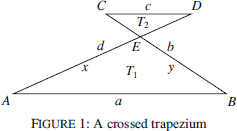No CrossRef data available.
Article contents
Metric relations in crossed trapezia
Published online by Cambridge University Press: 18 June 2018
Extract
The trapezium (trapezoid in American English) is one of the seven most well-known quadrilaterals that is studied in school geometry. However, it is always assumed that it is convex. In this note we shall derive metric formulas for the most important quantities in crossed trapezia and compare them to the similar formulas for convex trapezia. The corresponding investigation regarding crossed cyclic quadrilaterals was conducted in [1]. Any crossed quadrilateral has a pair of opposite sides intersecting and both of its diagonals are outside of itself.

- Type
- Articles
- Information
- Copyright
- Copyright © Mathematical Association 2018


